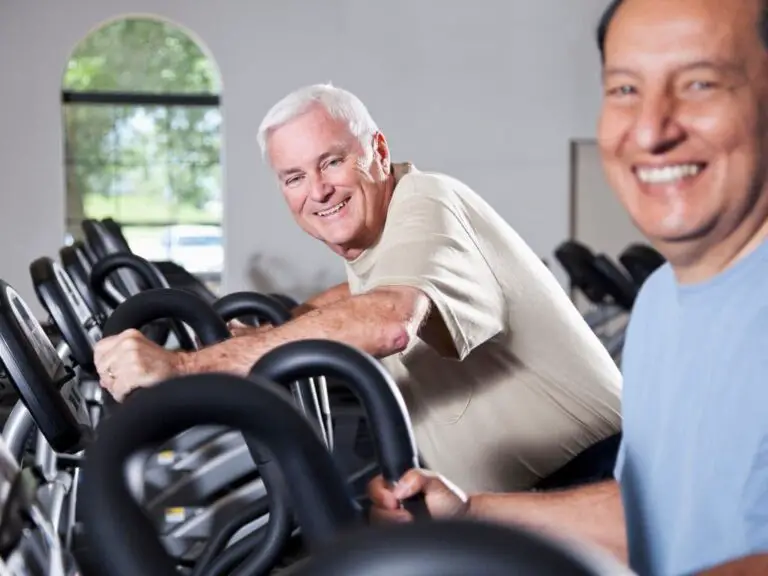How Much Weight Should a 70 Year-Old Man Lift?
Weight lifting can provide many important health benefits for seniors, including improved strength, muscle building, bone health, balance and mobility. However, it is crucial for seniors to lift weights safely and appropriately for their age and fitness level to minimize potential risks of injury.
A 70-year-old man should start with light weights, focusing on proper form and technique. Beginning with a weight as light as 1 to 2 pounds can be beneficial, and the amount can be increased gradually by small increments of 1-5 lbs over a period of 3-4 weeks. The goal should be to complete 2-3 sets of 12-15 reps per exercise, aiming for muscle fatigue. The weight should be enough to challenge the muscles without causing pain or discomfort.
This article will discuss the key factors that determine how much weight a 70-year-old man can and should lift to achieve maximum benefits from strength training while avoiding harm. We will cover the importance of considering individual fitness, health goals, proper form, starting light and gradually increasing weight, recommended exercises, safety tips and ideal frequency and programming. The aim is to provide seniors with personalized guidelines for safe and effective weight lifting.

What Factors Determine the Amount of Weight a Senior Should Lift?
The amount of weight a 70-year-old man can and should lift depends primarily on his baseline fitness level and overall health. It also depends on his specific goals from strength training.
Here is a table summarizing the key factors that determine how much weight a senior should lift:
| Factor | Description |
|---|---|
| Fitness Level | Seniors who are more active with higher baseline fitness can lift heavier weights. Less active seniors should start with lighter loads. |
| Health Conditions | Underlying conditions like heart disease, osteoporosis, arthritis, etc. may limit safe weight amounts. Consult a doctor. |
| Goals | The specific goals for weight lifting (building muscle, bone density, etc.) impact ideal weight loads. Tailor to aims. |
| Experience | Seniors who’ve lifted weights before may progress faster. New lifters should advance slowly. |
| Technique | Proper form and control is crucial to avoid injury. Keep weights lower until technique is mastered. |
| Progress Over Time | Weight should only be increased gradually as the senior’s body adapts over time. Patience is key. |
How Does Individual Fitness Level and Health Affect Weight Lifting for Seniors?
Seniors who are relatively fit and active can generally lift more weight than less active seniors. Health conditions like heart disease, osteoporosis, arthritis, chronic pain or mobility issues can limit how much weight is safe to lift. Consulting a doctor is important to rule out any underlying conditions that could make heavier lifting risky.
The more conditioned one’s muscles and bones are, the more weight lifting they can handle. Seniors who have lifted weights previously in life may be able to progress to heavier loads faster. Less active seniors may need to take a more gradual approach.
What Goals Should a Senior Have When Starting Weight Lifting?
The goals a 70-year-old man has for weight lifting will impact how much weight is ideal. Common goals include:
- Building lean muscle mass and strength
- Improving bone mineral density and slowing age-related bone loss
- Enhancing stability, mobility and range of motion
- Preventing frailty and loss of independence
Determining the target goals and customizing the weight lifting program is key for seniors.
What are the Benefits of Weight Lifting for Seniors?
Strength training with weights provides several valuable benefits for seniors related to enhancing muscle mass, supporting bone health and reducing frailty.
| Benefit | Description |
|---|---|
| Builds Muscle Mass | Weight lifting stimulates muscle growth and development to counter age-related loss of muscle mass (sarcopenia). |
| Increases Strength | Lifting weights makes muscles stronger, improving ability to perform daily physical tasks. |
| Enhances Bone Health | The controlled impact of weight lifting increases bone density and strength to protect against osteoporosis. |
| Improves Stability | Stronger muscles and bones from lifting weights helps improve balance and stability in seniors. |
| Boosts Mobility | Weight lifting maintains joint flexibility and range of motion, enhancing ease of movement. |
| Prevents Injuries | The added strength from weight lifting helps prevent falls and other injuries. |
| Supports Independence | Staying stronger in old age allows seniors to keep doing self-care and household activities independently. |
| Reduces Frailty | Weight lifting helps combat weakness and frailty in seniors. |
| Improves Posture | Strengthening the back, shoulder and core muscles improves senior posture. |
How Does Weight Lifting Improve Muscle Building for Seniors?
As we age, muscle mass naturally diminishes, a condition called sarcopenia. The loss of muscle can lead to weakness, fatigue, poor mobility and increased injury risk.
Weight lifting stimulates muscle fibers to grow and strengthen. This is called muscle hypertrophy. When seniors lift weights consistently, they can rebuild and maintain muscle mass and function.
How Does Weight Lifting Contribute to Bone Health in Seniors?
Osteoporosis and osteopenia cause bones to become weakened and brittle. Weight-bearing exercise like weight lifting applies controlled stress to bones which triggers the body to produce more reinforcing bone cells.
The impact of the weights enhances bone density and lowers the chances of dangerous bone fractures. Weight lifting may also help improve posture and alignment.
What are the Risks of Weight Lifting for Seniors?
While weight lifting positively impacts muscles and bones, injuries can occur if improper form and excessive weight amounts are used. Some risks include:
- Muscle strains and joint damage from poor technique
- Aggravating existing conditions like arthritis or back pain
- Loss of balance leading to falls
- Hernias from excess pressure
How Can Seniors Avoid Injury While Weight Lifting?
The key to avoiding injury is to lift appropriate amounts of weight using strict technique and working within limitations. Consulting a trained professional can help determine safe starting weights.
Starting very light allows muscles, bones, connective tissue and joints to adapt without too much stress. Using smooth, controlled motions instead of jerky movements is also crucial.
Seniors should listen to warning signs from their body like pain or excessive fatigue during workouts. Taking breaks helps prevent overexertion and injury. Proper breathing, hydration and nutrition also minimize risks.
How Can a Senior Start Weight Lifting?
Getting started with weight lifting requires choosing proper equipment, understanding intensity, and learning safe form.
The first step is to consult your physician to make sure weight lifting is appropriate for your health conditions and get advice on any precautions. Once cleared medically, decide on your goals for weight lifting such as building strength or improving bone density.
Next, enlist a personal trainer or physical therapist to help determine safe beginning weight amounts and teach proper lifting form and technique. Starting very light is crucial to allow your muscles, bones and joints to adapt without injury. Consider using dumbbells, resistance bands, weight machines or your body weight at first.
When starting weight lifting, focus on learning how to do the exercises correctly before increasing weight substantially. Go slowly, use controlled motions and prioritize strict form. Warm up properly before lifting sessions.
Initially aim for 1-2 sets of 10-15 repetitions for each major muscle group 2-3 days per week. When you can comfortably do the final repetitions with proper form, increase the weight minimally by 1-5 lbs. Give your body 3-4 weeks to adjust between small weight increases.
Listen to warning signs from your body like pain, strain or excessive fatigue. Stop an exercise if you feel discomfort. Use spotters if needed and keep rest periods between sets. Stay hydrated and stretch after finishing.
With patience and proper progression, a senior can safely achieve gains in muscle strength, bone health and physical function through weight lifting. Consistency and perfect form is key.
What Kind of Weight Lifting Equipment Should a Senior Use?
Expert recommended options for seniors include:
- Dumbbells with adjustable weights
- Resistance bands
- Weight machines with chest press, leg curl and lat pulldown attachments
- Suspension trainers like TRX bands for bodyweight exercises
The weights used should be specifically suited for senior strength – lighter than average adult weights. Accessible seated weight machines are ideal for those with mobility limitations.
What is the Importance of Starting with a Light Weight and Gradually Increasing?
The initial focus when starting weight lifting should be learning proper technique, not the amount of weight. Beginning with lighter loads allows the body to become accustomed to the new stresses and adjusts supportive structures like ligaments and tendons.
Weight can be progressively increased as the senior adapts but only by small increments of 1-5 lbs. Jumping up too quickly in weight raises injury risk substantially. Taking 3-4 weeks to move up each time is recommended.
Adding more repetitions or sets is an alternative way to build strength without suddenly lifting heavier weight. Patience and small increases are key for seniors.
What are Some Weight Lifting Exercises That are Safe and Effective for Seniors?
Certain weight lifting exercises are ideal for maximizing benefits for seniors while minimizing risk of harm.
Here are some examples of weight lifting exercises that are typically safe and effective for seniors when performed with proper form and appropriate weight:
One exercise seniors can start with are bicep curls using dumbbells to build arm strength. Dumbbell curls work to develop the biceps muscles which helps with lifting and carrying things like groceries or grandchildren. Make sure to keep good posture and squeeze the biceps as you curl the weight upward, then control the return.
The bench press is another good exercise for seniors that enhances upper body strength in the chest, arms and shoulders. This compresses the chest muscles and then works the triceps and shoulders as you push the weight back up. Be sure to use light weight and keep feet firmly planted for stability.
Squats are a key lower body exercise for seniors that improve quadriceps and glute strength to boost mobility and balance. Perform squats by sending hips back with a neutral spine as you bend knees and lower down. Descend slowly then power back up through the heels.
Lunges target leg muscles like the quadriceps and hamstrings to build stability for walking and climbing stairs. Step forward lowering your back knee toward the ground, keeping your torso upright. Make sure the front knee doesn’t go past toes. Push back to start position.
How Can Dumbbell Curls, Bench Press, Squats, Lunges, Push-ups, and Pull-ups Benefit Seniors?
Recommended exercises include:
- Dumbbell curls to build biceps and improve arm strength for daily tasks like lifting grandchildren or groceries
- Bench press to enhance upper body power needed for pushing, pulling and stabilization
- Squats to strengthen lower body muscles like quadriceps and glutes for better mobility and balance
- Lunges to develop leg strength and stability for walking, stairs and preventing falls
- Push-ups to tone multiple upper body muscle groups that aid in mobility
- Pull-ups to work back and bicep muscles for posture, shoulder health and reaching
All exercises should be done slowly and with light weight as seniors adapt. 12-15 reps aiming for muscle fatigue is ideal for hypertrophy.
What are Some Weight Lifting Safety Tips for Seniors?
To ensure safety while weight lifting, seniors should follow these precautions:
- Warm up muscles thoroughly before lifting with 5-10 minutes of light cardio and targeted stretches
- Use controlled, full range of motion to maximize benefit and reduce strain
- Maintain proper breathing during the lift – no holding breath
- Keep hydrated and rest between sets to avoid fatigue
- Prioritize form and technique over amount of weight lifted
- Listen to body’s pain signals and stop an exercise if discomfort arises
- Ask for assistance from a spotter when needed
Why is Focusing on Proper Form Crucial in Weight Lifting for Seniors?
With age, joints and connective tissue lose flexibility. Using improper form with heavy weight can overstress vulnerable joints like knees, elbows and shoulders resulting in pain or injuries.
Receiving instruction on correct lifting techniques from a personal trainer can help seniors focus on precise form. Always maintaining control and alignment reduces risk. Slow, stable motions are key.
How Often Should a Senior Lift Weights?
Current recommendations advise moderately active seniors lift weights at least 2-3 times per week on non-consecutive days. More active seniors could increase to 4 times weekly.
Rest days in between sessions are important to allow muscles adequate recovery and repair time. Overtraining can lead to strain and failed gains.
Each session should last 45-60 minutes. Major muscle groups can be targeted on different days – chest/arms day, legs/shoulders day, etc.
What is the Best Weight Lifting Program for Seniors?
A complete program will include:
- 8-10 strength training exercises involving all major muscle groups
- 2-3 sets of each exercise
- 12-15 reps performed per set
- Lifting a weight amount that fatigues muscles by last rep
- Focusing on full range of motion and proper form
- Progressing weight minimally every 3-4 weeks
Why is it Important to Talk to a Doctor or Physical Therapist Before Starting Any New Exercise Program?
Seniors with chronic conditions, prior injuries or balance issues should consult a physician or physical therapist to ensure weight lifting will be safe and beneficial. They can help determine precautions, recommended weight amounts, exercises to avoid, and any adjustments required.
Speaking with a professional first reduces injury risk and optimizes the rewards you can gain. They can also provide guidance on technique and building an optimal program.
Conclusion
Weight lifting provides substantial strength, muscle, bone and functional benefits making it an ideal exercise for seniors. By starting with light weight, learning proper form and technique, gradually increasing intensity, and exercising regularly, 70-year-old men can safely achieve their fitness goals through weight lifting. Being mindful of risks, starting slowly and listening to your body ensures optimal results.
Frequently Asked Questions
-
How often should a 70 year old man lift weights?
Jasmine Marcus, DPT and Physical Therapist recommends strength training for older people at least two times per week. A 2011 study also suggests that greater frequency up to three or four times per week may be safe.
-
Can you feel when death is coming?
Are there any signs that indicate death is imminent? A person who is close to death may refuse water and food. They may have a slowing or abnormal breathing rate, and they might feel cold to the touch. You may feel anxious or agitated.
-
What age should you stop doing push-ups?
Again, quit body-weight exercises – push-ups, pull-ups, dips – after age 40. Do not attempt to fail at any exercise. You could end up with injury if you do this.
-
How do you reverse age related muscle loss?
The best way to reverse the effects of sarcopenia is through exercise. For strength and muscle growth, resistance training is the best option. Combination exercise and walking can also combat sarcopenia.
-
Can you gain muscle after 70?
Seniors can still bulk up on muscle by pressing iron. As we age, our muscle mass drops at astonishing rates. Researchers found that lifting weights can help people over 50 not only preserve but even increase muscle mass.
-
Is 20 minutes of walking a day enough?
According to research released Jan. 14, a 20-minute walk every day can reduce your chances of dying young even if obesity is a factor. A study of over 334,000 European women and men found twice the number of deaths due to inactivity than obesity.
-
Is it good to do push-ups before bed?
He said that pushups and bicep curls can be done in a few minutes and will increase your muscle endurance and improve your sleep quality. You can get more deep, restorative sleep by strengthening your muscles.
-
Should you do push-ups fast or slow?
You must think fast. Do you want a larger chest? Get down to the ground fast. According to The Journal of Strength and Conditioning Research, pushups can be one of the most effective ways to increase upper-body strength.
-
How heavy should dumbbells be for seniors?
For your lower body exercises, you can use 15-pound weights and 5 or 7.5-pound dumbbells. You can then gauge your ability from there. Araujo states that it is more important to choose a weight you are able to control.
-
What causes leg weakness elderly?
Poor circulation is caused by diabetes and atherosclerosis. However, they can also be linked to smoking, inactivity, high blood pressure, cholesterol, and living a lifestyle that favors inactivity. Lower extremity weakness can be reduced by elevating your legs when you sit or lie down. This will increase circulation.
-
What vitamin is good for muscle loss?
Vitamin D has been shown to be effective in preventing muscle loss. Lower vitamin B12 levels are associated with sarcopenia and lower vitamin C and E with fraility. However, it is not known how vitamin D and vitamin E affect older adults with diabetes.
-
How long after working out do you start to see results?
If a consistent resistance training program is used, one can expect to see an improvement of 25-100% in muscular fitness within three to six months. The neuromuscular connections that learn how to move are responsible for most of these early gains in strength.
-
How many pushups should a 70 year old man do a day?
Six pushups are the national norm for 60-year olds. For men it is 17 and for women six. So by 70, you might want to do three pushups and for women eight-10.
-
Should I plank on elbows or hands?
The elbow plank strengthens your abdominal muscles. This is a fact that everyone agrees upon and it’s easy to feel if you try out different planks. The elbow plank is more gentle on your wrists. If your wrists are strained by straight arm planks then elbow planks might be a better option.
-
What will happen if I do a 1 minute plank everyday?
The planking exercises improve your posture and strengthen your neck, shoulders, back, stomach, shoulder, hip, and abdomen muscles. Your posture will improve if you plank daily. You’ll have straighter back.







